With enough time to capture a couple of weeks of data after the fast, it is now possible to take a look at what the results were from the fast as well as to discuss how I felt about it overall and potential tweaks for the future. This is the final post in this series for my first go of this fast. The usual disclaimer applies though. I am not a doctor, trainer, dietitian, nutritionist, or any other expert in any related field. I’m talking about my amateur and anecdotal experiences here and none of this should replace expert medical advice.
You can find the other posts at:
- Recipe for the transition in/out day soup
- Description of the My Longo Inspired Cancer Avoidance Fasting protocol
- Fasting Day 1 Journal
- Fasting Day 2 Journal
- Fasting Day 3 Journal
- Fasting Day 4 Journal
- Fasting Day 5 Journal
Performance Summary
If one read the journals from each of the days then they can see that for me it was a mostly uneventful. This wasn’t my first time doing a prolonged fast, as I talked about in this post . This was the most controlled entry and exit that I’ve ever had. As I wrote previously, I wanted to get a five day fasting window but have only 3.5 days of “water” fasting at the core. I therefore came up with the above recipe for the soup that I’d eat for the transition in and out days. This is also the first time I was going to not be consuming broth for “dinners” on the “water” fasting days. In previous iterations of this that was something I always did which I think helped make it easier. Instead, if necessary, I’d use electrolyte powders if I felt my electrolytes were getting out of whack. Lastly, this was the first fast that I had a stretch goal of not consuming any of the diet sodas that I regularly consume in volume each day. Instead all liquids would ideally be water, black unsweetened coffee (regular or decaf), tea, seltzer water, or Perrier/Pelligrino mineral water.
When all was said and done the last real calories I ate on the tranistion in day of the fast was at 7 pm on July 5th and the first real calories I ate to break the fast was the broth at 9 am on July 9th. That meant 86 hours, a bit over 3.5 days, with no calorie consumption. There were neglible calories in the coffee I drank. Those added up to 2-4 calories per day in total. Much of the coffee was decaf so that on no one day did I exceed my personally imposed preferred maximum caffeine consumption of 150 mg (that is about where chemical dependency can begin). On the pure fasting days the water consumption was just about the RDA, hovering around 4 liters. Since none of it was coming from “food” that all had to be consumed as beverages. Those beverages were all coffee, canned seltzer water, or bottles of Perrier/Pelligrino mineral water.
Despite having them available I never felt the need to use the electrolyte powders during the fast. I very much craved but never gave into the indulgence of having any of my diet sodas. Those two things definitely made the fast a bit more difficult because it didn’t really have much variety of flavors and mouth feels throughout the 3.5 days. But in the end there were no real complications or difficulties besides the usual cravings for food that one would expect to some degree.
The more methodical transitions in and out proved to be pretty well designed for me. I realize in hindsight that the volume of fiber consumed with the 13 cups of soup I am scheduled to eat on those days is more than 100% of the daily value recommended. Most people don’t eat anywhere near the daily value of fiber either. It could therefore have proven very difficult for others to do this. My system is used to it so for me it worked out fine, with the exception of the pacing on the transition out day. The soup is essentially one big vat that can be eaten throughout the transition in and out day. For transition out one wants to gradually introduce more food. I did it a little too gradually. What I ended up with was a dinner serving that was way too large for the end of the fast. Although it was the same volume that I ate for lunch and dinner on the transition in day, it proved to be a lot more of a challenge at the end of the last day. It was doable but a bit of a challenge.
When I do another one of these fasts, probably beginning of next year, I intend to follow pretty much the exact same protocol but with faster consumption of more of the soup throughout the afternoon so that the dinner portion is more normal. Overall I considered it a success. How did my biometric data change from the fast though?
Biometric Changes
Since the primary reason why I’m doing these fasts is to potentially reduce my cancer risk shorter term changes aren’t necessarily a target for me. However this is a relatively extreme experience I am putting my body through. It is therefore instructive to see how things like body mass, fat mass, heart rate, etc. change. Ideally I’d have blood test data before and after as well but I do not. Instead what I have is data that I regularly measure, mostly daily, about my body. Those are: weight, body composition, resting heart rate, heart rate variability, blood pressure. What I therefore want to do is look at changes in those values for two weeks before the fast, during the fast, and two weeks after the fast. Is there a trend and what is it? There are some big limitations in my data however.
The first big limitation is that the body composition is measured using the Withings Scale which uses a bioelectrical impedance analysis (BIA) method to measure body composition. This measurement type is very noisy. It can be heavily affected by levels of hydration, time of day it is taken, changes in skin surface conductivity (just out of the shower, just out of bed, etc). I also find it very sensitive to the volume of food in the digestive system. That obviously is going to have a huge impact during the fast. For me it is also 5-6 percentage points low always. I therefore find it useful for longer term trends but useless for absolute level estimation and in short term analysis. Literally from one day to another under normal circumstances it can change by two percentage points. Under fasting conditions the changes will be more dramatic.
The second big limitation is the blood pressure measurements. I had an old digital Omron unit until the second day of the fast. They were a bit cumbersome, didn’t tie into apple health, etc. I replaced it on the second day with a much more convenient Withings BPM+. I therefore started doing at least daily morning blood pressure readings on the second day of the fast. My data prior to that is more intermittent and from various times through the day. They therefore aren’t a complete apples for apples comparison.
The third big limitation is that the heart rate data is coming from the Apple Health ecosystem. Calculation of resting heart rate and heart rate variability are complicated and every system is proprietary. The Apple Watch heart rate sensor is a pretty good wrist-based optical sensor but that sensor type is a pretty mediocre way of measuring heart rate. It is just incredibly convenient. The accuracy and precision of these calculations therefore are good but not great. Like with the BIA based body composition number I look at it for trends not absolute values, although I think that they aren’t as noisy or off in absolute value as the BIA numbers are.
The fourth big limitation is that this fast was done in the middle of my fitness reset. This is a longer term weight loss and fitness improvement goal. I therefore am eating an average of 750 calories a day deficit for weeks before and after. My exercise volume is changing throughout. For example part of the way through the two weeks before I completed a three week weights training routine and didn’t lift weights again for the rest of the data window. Simultaneously I started ramping up my running and cardio routines as that weight training went out. During the fast and just after I kept exercise levels lower to give my body more time to adjust. Lastly part of the data window includes some big feast days like the 4th of July. I therefore don’t have a steady state diet and fitness lifestyle leading up to or going out of the fast. All of these numbers therefore can be affected by these non-fasting related changes. For example the 750 calorie restriction combined with eliminating weight training would probably lead to a small reduction in lean body mass and fat mass. Drawing conclusions of how much body composition change is influenced by the fasting versus the other changes will be difficult.
With all that said, lets look at the data starting with overall weight:
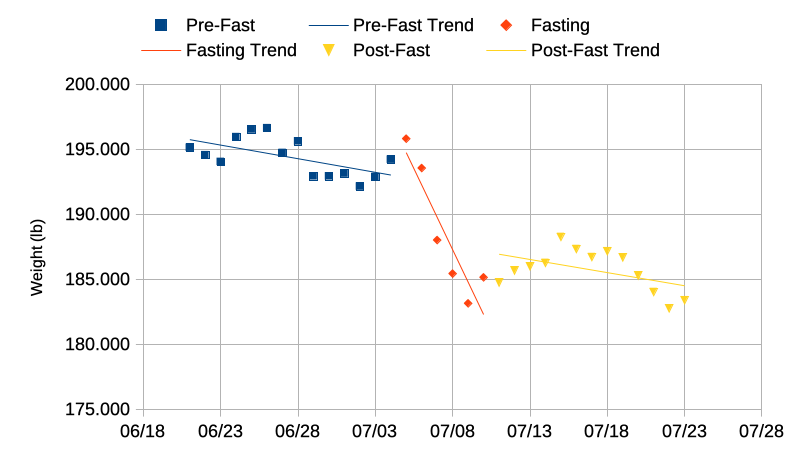
There was obviously the expected large weight change during the fast but that was pretty substantially held after the fast. If we look at the two week average before and after the fast the average weight is just over 8.5 pounds lower after the fast. How much of that is fat loss and how much of that is muscle loss? Looking at it from a body composition perspective:
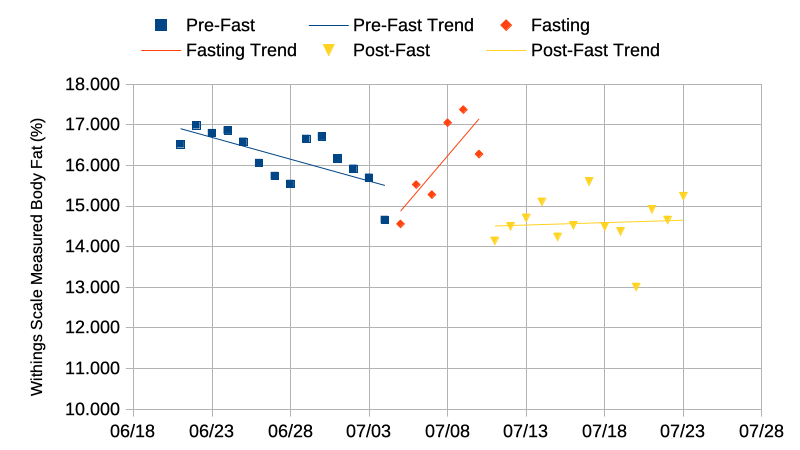

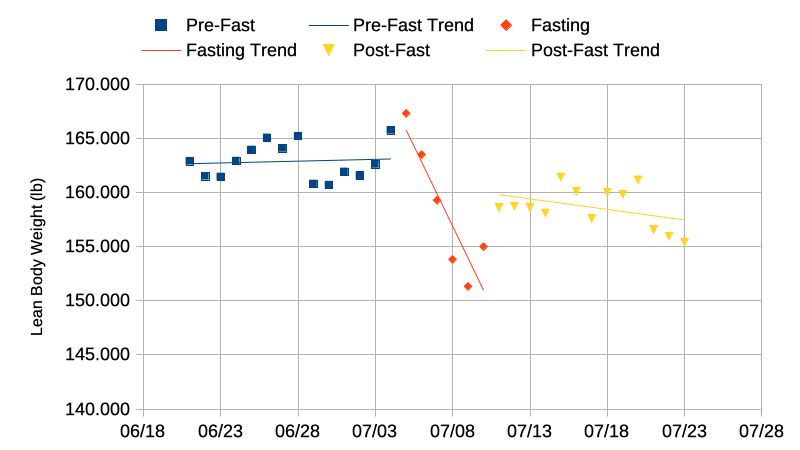
Body composition data during and just after the fast is going to essentially be wrong as the lack of food in the digestive system drastically changes the values. It is therefore important to look at the pre and post averages and trends only. Percent body fat definitely dropped dramatically after the fast. The corresponding changes in body composition are a bit more interesting. Overall it appears that half of the loss was muscle and half of it was body fat. Based on just the two weeks before/after trends it appears that fat mass loss has ended and lean mass trends went from slightly positive to slightly negative. Part of that is the noise caused by the fluctuation in fat mass from the early post-fast period. I think part of that is the cutting off of weight training part of the way through the pre-fast period data as well. When we look at the longer weight and percent body fat trends we see the overall longer term trends are pretty comparable both before and after.


Looking at the heart rate data things are a bit more ambiguous:
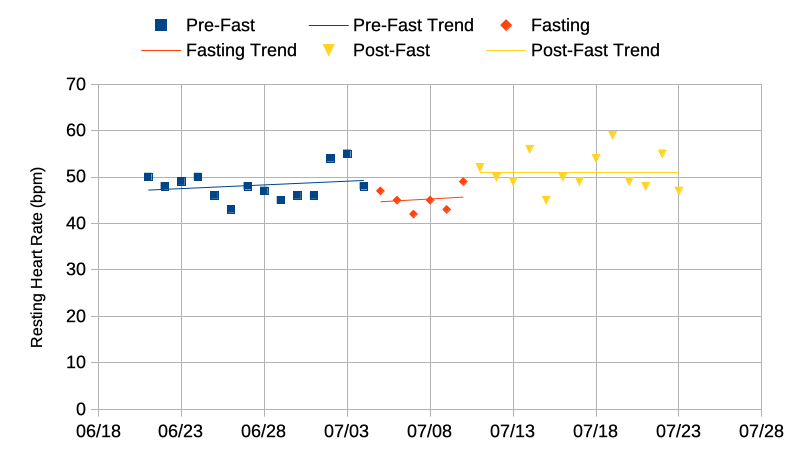
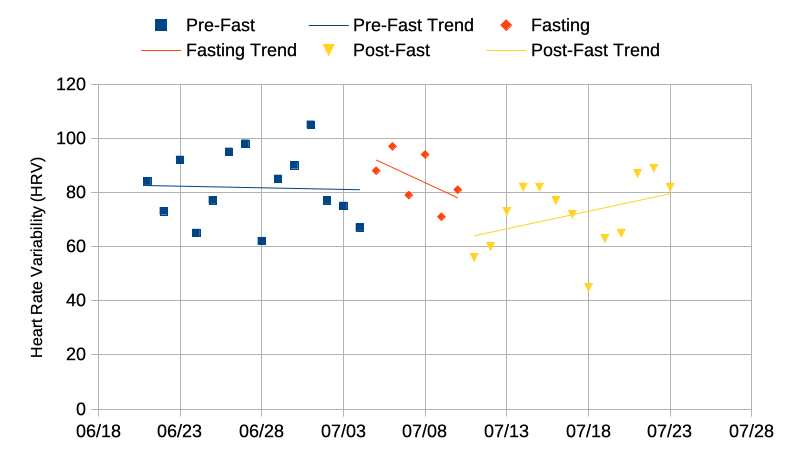
The resting heart rate (RHR) during the fasting window definitely dropped a bit. But the pre and post RHR average is pretty much the same. The variation in values is actually pretty much in the noise. I would kind of expect my RHR to be a bit lower during the fast itself because I essentially stopped all exercise and was extremely sedentary. While over the long term that causes my RHR to increase as I become less physically fit. In the short term I often see this sort of reduction, assuming that the extra sedentary behavior isn’t paired with eating a lot of junk food, drinking a lot of alcohol, illness etc. The heart rate variability (HRV) was adversely affected by the fast but still within the normal ranges of variation I can see from day to day. The overall trend up in the post-fasting period I think is being artificially skewed by the much lower value coming out of the fast. Blood pressure is a bit more problematic to study for various reasons:
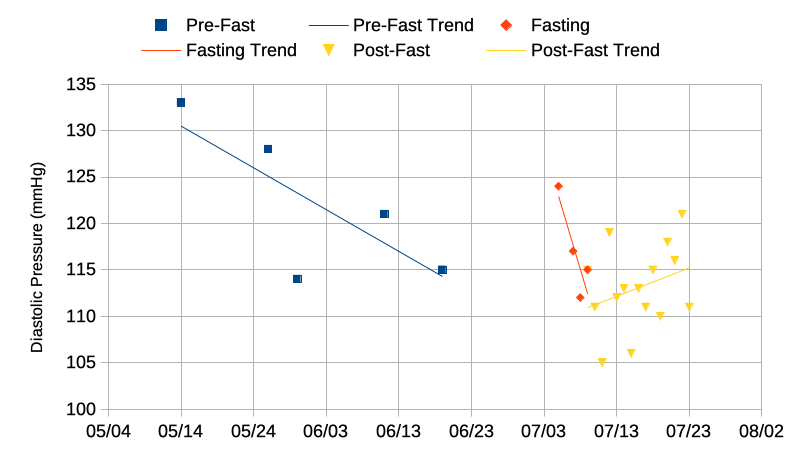
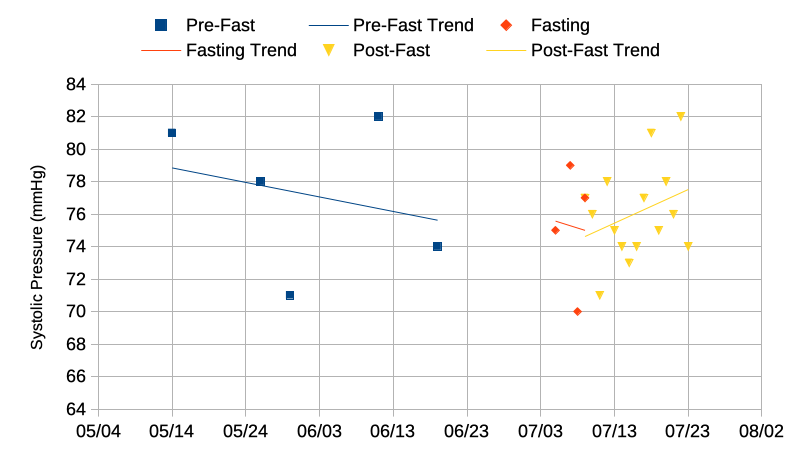
Because I have lower frequency data on blood pressure I had to extend this chart out to more than just two weeks before. Since a big part of the fitness reboot was getting my blood pressure more under control you can see a general down trend in those values as my diet and exercise got more dialed in. I unfortunately don’t have a data point immediately before the fast. That said there was a pretty consistent drop in diastolic pressure during the fast and directly after. The systolic pressure is a bit noisier in the two weeks after, appearing to revert back to the mean level by the end of the two weeks. The current average of those values several weeks out has settled in the mid-110s over mid-70s however. Looking at the blood presure during the transition day was more interesting though:
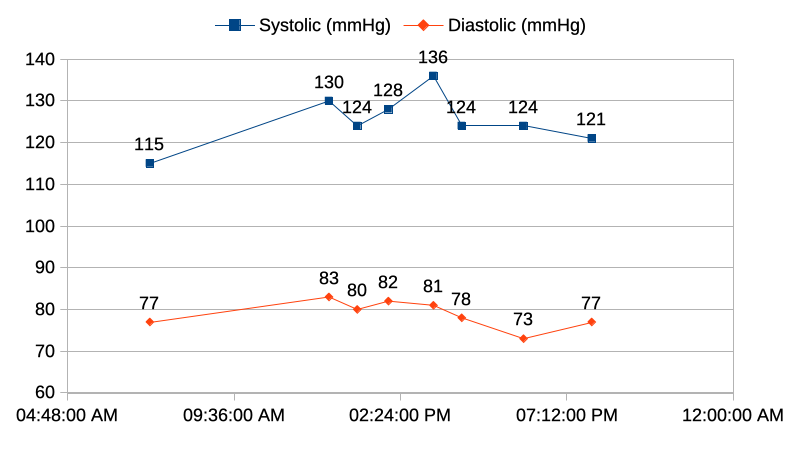
One of the concerns with prolonged fasting is the possibility of the transition out triggering refeeding syndrome . One of the dangers of the symptoms of that can be a dangerous drop in blood pressure levels. Ironically my body was having the opposite reaction to the increasing food consumption. No, this wasn’t being caused by a spike in excess sodium consumption. The transition soup recipe only has 731 milligrams of sodium in it as I made it and the electrolyte powder consumed bumped the total sodium consumption for the day to just 1022 milligrams for the day. There were no experiential changes caused by it. I’ve subsequently taken some measurements throughout the day to see if I always have some during the day fluctuation that has a similar pattern and I do not. I’m therefore curious what that will look like in the next fast and see if this is a standard reaction for my body. While the spike is in the Stage 1 hypertension zone it was only there briefly and was back to my new lower (and normal) levels by the next morning.
Conclusions
With my first run of my Longo Inspired Cancer Avoidance Fast complete I’m pretty pleased. I finished it as strong or stronger than any of the previous fasts. I was surprised to see that there wasn’t more rebound in the body weight once I started eating normally again. Part of that is explained by the lean muscle loss along with the fat loss. Some prolonged fast practitioners claim that in these sorts of fasts almost all the weight is fat loss. That obviously wasn’t the case here. Is that a byproduct of the exercise changes and background calorie restricted diet before and after? I honestly can’t say. Other practitioners guard against elderly people doing these sorts of things because of the corresponding lean muscle loss. If in subsequent ones with more stable background diet and fitness I see that much loss again I would be inclined to listen to the warnings of practitioners who state that it isn’t worth it for elderly people.
The lack of changes in RHR and HRV is not especially interesting but good to know. If there were dramatic changes in that in the short term that could have been indicative of a more dramatic body change. My blood pressure changes are inconclusive because of my data set. It is possible that the fast lead to a lowering of my blood pressure I just don’t have the data. There is background weight loss before and after and an increase in cardiovascular fitness that could be driving that as well.
So did this fast do anything for me? In the short term it may have lead to a more dramatic fat loss but that was tied with potential muscle loss too. The rest of the numbers are sort of in the noise as well. However I wasn’t expecting dramatica changes in those numbers either. My rational for doing this was always the longer term trends anyway and I don’t really have any way of quantifying that except maybe looking at how IGF-1 (a biomarker correlated with cancer risk) changed immediately before and after the fast and then how it evolves over time.
I have much better instrumentation of biometric data that is important to keep track of, especially the blood pressure. I have a well established transition in and out eating strategy that worked for me. It still has room for some tweaks though. The first big tweak is to make sure I have better consistent measurements before, during, and after the fast. That is especially true of the blood pressure, which I think I have dialed in now. I probably should also start introducing blood glucose monitoring and perhaps keto strips as well to get data on those changes and to determine how my body is reacting to that in the shorter term.
The second is that I need to have better pacing of the transition out eating. I left way too much soup to be eaten later in the day. It didn’t cause me any GI distress but there was no need to be so timid with the eating earlier in the day. The third is that if possible it would be ideal to be able to hold lifestyle, diet, and fitness constant for the two weeks before and after in order to be able to capture the changes through the fast itself. This last point is more of a nice to have though. If I’m part of a weight loss, muscle gain, or distance race training, that will take precedent. Again, for me this is for long term cancer avoidance potential not short term gains or scientific inquiry. It would just be nice to have one iteration where I have tighter data.
Should someone else use this fasting protocol? That is something for you to take up with your doctor or health care professional. I’ve tried to design something that I think is safe for me based on how I know my body, my previous fasting experiences, and my overall health levels. I cannot predict how another person’s body will react to this. I will say that the transition meal plan soup while fine for my digestive system could be problematic for other people’s. I eat a pretty high fiber diet and my digestive system adapts very quickly to large increases in fiber intake. Other people are not in that position. That is why it is important to discuss this with medical professionals before undertaking something like this. In the end the only truly safe water fasting method is to do one in a reputable controlled medical environment under daily observation.




 2023-08-07
in
2023-08-07
in

 15 min read
15 min read